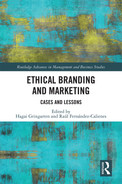Preface
The Ethical Branding book is unique because it is ethical branding focused. It provides current perspectives on fascinating global cases. The approach is to focus on the specific combination of the two fields of “ethics” and “branding,” on their relationship, and on how that joint perspective shapes brands, companies, business strategies, and the market itself.
In a contemporary environment of “truthiness” and fake news, it is more important than ever to review core principles of ethics and to reassess how these principles apply to today’s branding and marketing practices. This book addresses practices in ethical branding and corporate culture. It includes such topics as truth, integrity, value, vulnerability, and differentiation. Collectively, these cases provide a contemporary overview of intriguing scenarios and best practices in ethical branding.
The book’s themes include ethics, branding, marketing, business, business communications, and business history. Its objectives include the following:
provide the reader with real, updated insight into ethical decision-making;
help students integrate ethics, branding strategy, and real life, complex situations into an effective learning process; and
provide the reader with up-to-date ethical branding cases from around the world.
This book will have international appeal, not only in primarily English-speaking countries but also in nations known for commerce, trade, marketing, and other aspects of business – nations such as Brazil, China, India, Singapore, and others.
Background
Increasingly, firms realize that branding is one of the most valuable intangible assets that firms have (Holt, 2003; Keller & Sood, 2003; Kellogg, 2010).
In his forward to Kellogg on Branding (Tybout & Calkins, 2005), Kotler argued that in this day and age of the quiet revolution of the digital age, change accelerated to levels never before experienced. There are only two answers to the marketing challenges of today: One is to know the customer, and the other is to differentiate through branding.
Kotler and Keller (2009) defined branding as “endowing products and services with the power of a brand” (p. 142). They noted that branding is the act of creating differences between products. While many researchers try to reach a consensus on defining the term brand, branding is being redefined continually.
The American Marketing Association (2009) defines brand as “A name, term, design, symbol, or any other feature that identifies one seller’s good or service as distinct from those of other sellers” (n.p.).
Velasquez (2012) defines “business ethics” as “a specialized study of moral right and wrong that focuses on business institutions, organizations, and behavior (p. 15).
The combination of these two terms would seem, then, to be a major element of contemporary business operations – and study. Yet, in practice, one finds a gap in the literature.
As important as branding ethics may appear to be, the terminology within recent university and business school textbooks in these fields is incomplete. A review of some of the leading texts on business ethics shows that the words “branding,” “branding ethics,” and “ethical branding” do not appear in the index (see, e.g., Audi, 2009; Boatright & Smith, 2017; Stanwick & Stanwick, 2009; Velasquez, 2012). Even a little analysis reveals the gap, a missing step in the process of thinking about – and acting – in relation to ethical branding. The fact of this gap is part of the origins of the present work.
How to Use this Book (Teaching Notes)
Ethical Branding can be of use in many different settings. For scholars, it offers new and unique sources of information and material for research and writing. For instructors, it provides a single work that centralizes data, cases, and examples. For students, it unites streams of thought and experience into a united whole that facilitates understanding of relevant fields. It also provides Discussion Questions that bring together various aspects of the cases for engagement and decision-making in response as well as for developing critical thinking skills.
This book is a solid complement for instructors and students in the field of marketing and business, serving as an updated addition and supplement to the subject.
Through specific pedagogical features, the book highlights a best practices approach, so students, instructors, and others can access the book more easily and efficiently.
Organization of the Book
Ethical Branding is organized alphabetically by author’s last name. Each chapter includes pedagogical features such as Abstracts, Keywords, Cite-Ready References, DOI Numbers, Further Readings, TOC-RSS Feeds, Links, and Indexes. In addition, the book includes a section entitled Check Your Understanding, which provides brief definitions or comments in boxes on the margins to highlight and communicate important elements to the reader. Each chapter also includes Discussion Questions that can serve as a method of assessment or a way to start conversation about the relevant themes and topics.
References
American Marketing Association. (2009). Branding definition. Retrieved from https://www.ama.org/resources/Pages/Dictionary.aspx
Audi, R. (2009). Business ethics and ethical business. New York, NY: Oxford University Press.
Boatright, J. R., & Smith, J. D. (2017). Ethics and the conduct of business (8th ed.). Boston, MA: Pearson.
Holt, D. B. (2003, March 11). What becomes an icon most? Harvard Business Review, 81, 1–12.
Keller, K. L., & Sood, S. (2003). Brand equity dilution. MIT Sloan Management Review, 45, 12–15.
Kellogg School of Management. (2010, May 23–26). Kellogg on branding: Creating, building, and rejuvenating your brand, Kellogg School of Management’s executive course on branding. Evanston, IL: Northwestern University.
Kotler, P., & Keller, K. L. (2009). Marketing management (4th ed). Upper Saddle River, NJ: Pearson Prentice-Hall.
Stanwick, P. A., & Stanwick, S. D. (2009). Understanding business ethics. Upper Saddle River, NJ: Pearson Prentice Hall.
Tybout, A. M., & Calkins, T. (2005). Kellogg on branding (1st ed). Hoboken, NJ: John Wiley & Sons.
Velasquez, M. C. (2012). Business ethics: Concepts and cases (7th ed.). Boston, MA: Pearson.
